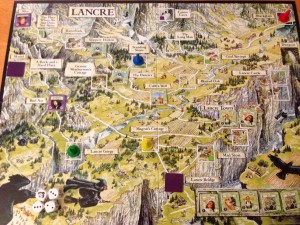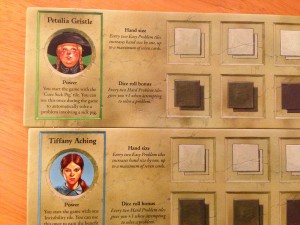Mike O’Raw guffaws at the Discworld references
 So far in Cards, Dice & Tabletops all of the games we have looked at require players to play with or against. But just for a second think about a game where the board is also in essence a player. I’m talking about a game where the board has certain tasks to carry out. These can lead to chain reactions, the game ending and, in some cases, scenarios where nobody wins except the evil piece of cardboard in the centre of the table. Sound intriguing? Well, I’m glad to report that this concept is not simply my imagination running wild. Elements of this idea can be found in games such as Battlestar Gallactica, Pandemic and today’s game, The Witches. It is also centred around Terry Pratchett’s Discworld witches so it automatically gets some extra cool points.
So far in Cards, Dice & Tabletops all of the games we have looked at require players to play with or against. But just for a second think about a game where the board is also in essence a player. I’m talking about a game where the board has certain tasks to carry out. These can lead to chain reactions, the game ending and, in some cases, scenarios where nobody wins except the evil piece of cardboard in the centre of the table. Sound intriguing? Well, I’m glad to report that this concept is not simply my imagination running wild. Elements of this idea can be found in games such as Battlestar Gallactica, Pandemic and today’s game, The Witches. It is also centred around Terry Pratchett’s Discworld witches so it automatically gets some extra cool points.
The Witches is the second in a planned series of three Discworld games by Martin Wallace. The first, Discworld Ankh-Morpork centred on four of Ankh-Morpork’s main residents as they vie for the leadership of the city. This time we are whisked away to Lancre where players take on the role of a trainee with names such as Tiffany Aching. You are basically flung into the middle of being a helpful and busy wee witch as you solve various problems all over Lancre. Some of the problems may be as mundane as a sick pig or as serious as the resurgence of Count Bela de Magpyr. But you better be quick in solving them because problems can turn into a crisis at the turn of a card, get too many crisis and its game over.
 Scattered throughout Lancre are various locations made famous by the Discworld books such as The Place where the sun does not shine, A rock and a hard place and The Long man. Several of these locations start the game with problem tiles placed on them that the trainee witches must take turns to travel to and attempt to solve. The problems are solved by rolling four dice equal to or higher than a predetermined number printed on the tiles. Green easy problems normally have a value between eight and twelve and should be easily rolled away. The purple difficult problems have values ranging between twelve and twenty two and may require some luck and help from the cards you have in your hand. The cards may let you re-roll die or even solve a specific problem altogether. Each problem also has a point value and the player with the most points at the end of the game is the winner.
Scattered throughout Lancre are various locations made famous by the Discworld books such as The Place where the sun does not shine, A rock and a hard place and The Long man. Several of these locations start the game with problem tiles placed on them that the trainee witches must take turns to travel to and attempt to solve. The problems are solved by rolling four dice equal to or higher than a predetermined number printed on the tiles. Green easy problems normally have a value between eight and twelve and should be easily rolled away. The purple difficult problems have values ranging between twelve and twenty two and may require some luck and help from the cards you have in your hand. The cards may let you re-roll die or even solve a specific problem altogether. Each problem also has a point value and the player with the most points at the end of the game is the winner.
Remember how I said the board was a player in this game? Well, before a player begins their turn a new problem tile must be placed on the board. This is done by using the same cards that you draw from to make your hand. Apart from containing effects and instructions that will help in solving problems, they also contain a location name that is used to place the next problem tile. If a card is drawn that names somewhere that already has a problem on it, the problem becomes a crisis and you draw another location until you are able to place a problem. There is however a limit to the number of crisis that can be on the board at one time, reach that limit at the beginning of a turn and fail to deal with any one crisis and the game ends prematurely. Also, should you not be able place a problem due to lack of free space or have too many problems on the board, the game will again end prematurely. The unpredictability of this process adds to the craziness of this game and the simulation of daily witch life on the Discworld.
 The Witches is a lovingly crafted game that just oozes everything that Terry Pratchett’s books envelope. For example, should a player need to remove some of their craziness (indicated by cackle counters) before they go Black Alice, they meet up to have tea because that is what witches do when they get together. There are also certain consequences that will happen should a witch fail to take care of a certain task. These will always reference an event from one of the books and give you a knowing grin. The game also has a few different ways to play it. In addition to the way described above The Witches can also be played as a cooperative game or even be played by one player. In a cooperative game, players must work together to ensure there are no more than three purple problems on the board at the end of a game. Whereas, solitaire mode sees a single player trying to achieve the highest possible score within a set number of rounds. This is a really neat touch to make a very playable game extremely playable.
The Witches is a lovingly crafted game that just oozes everything that Terry Pratchett’s books envelope. For example, should a player need to remove some of their craziness (indicated by cackle counters) before they go Black Alice, they meet up to have tea because that is what witches do when they get together. There are also certain consequences that will happen should a witch fail to take care of a certain task. These will always reference an event from one of the books and give you a knowing grin. The game also has a few different ways to play it. In addition to the way described above The Witches can also be played as a cooperative game or even be played by one player. In a cooperative game, players must work together to ensure there are no more than three purple problems on the board at the end of a game. Whereas, solitaire mode sees a single player trying to achieve the highest possible score within a set number of rounds. This is a really neat touch to make a very playable game extremely playable.
I really like the randomness of The Witches. It uses a fun gameplay mechanic that ensures that no two games will end the same way. In the competitive game you normally end up playing a little bit cooperatively to ensure the game ends naturally which is rather unique and did impress most of our playtest group. In closing, The Witches is a fun game for game fans and absolutely fantastic for Discworld fans. It is highly recommended, just don’t tell the Lord and Ladies I said that!
